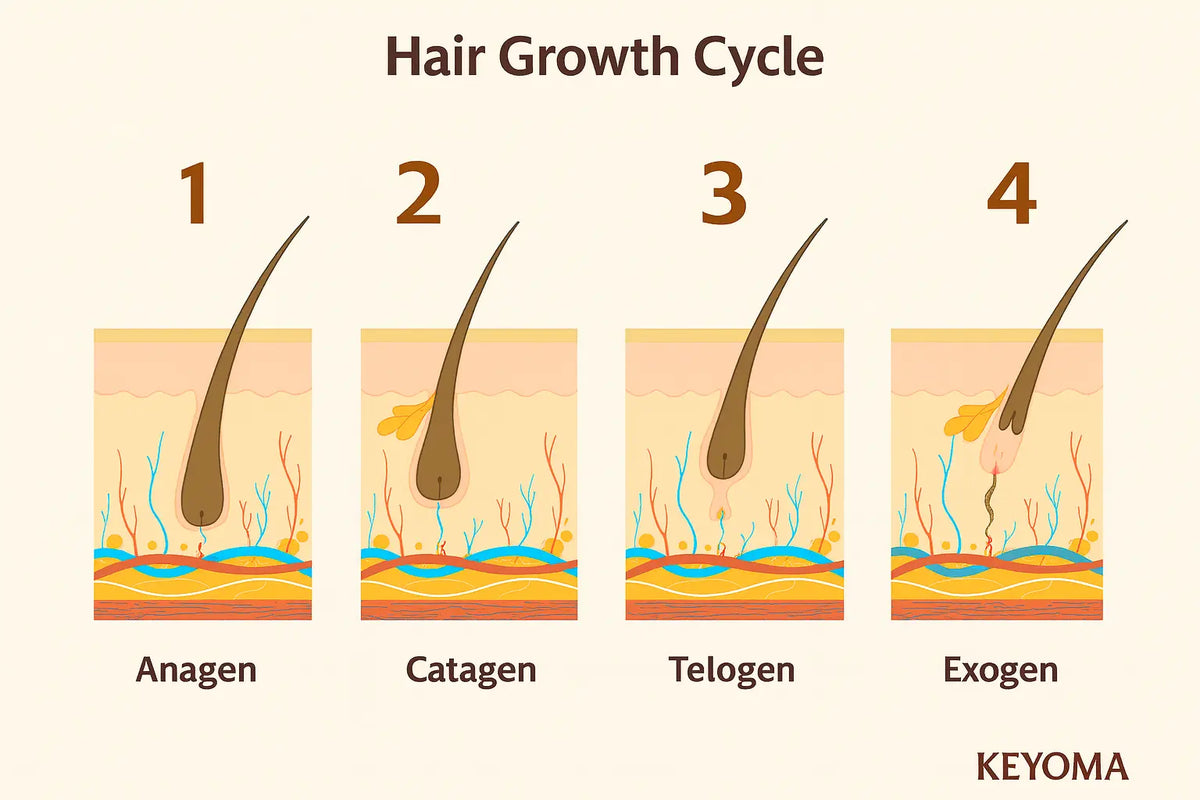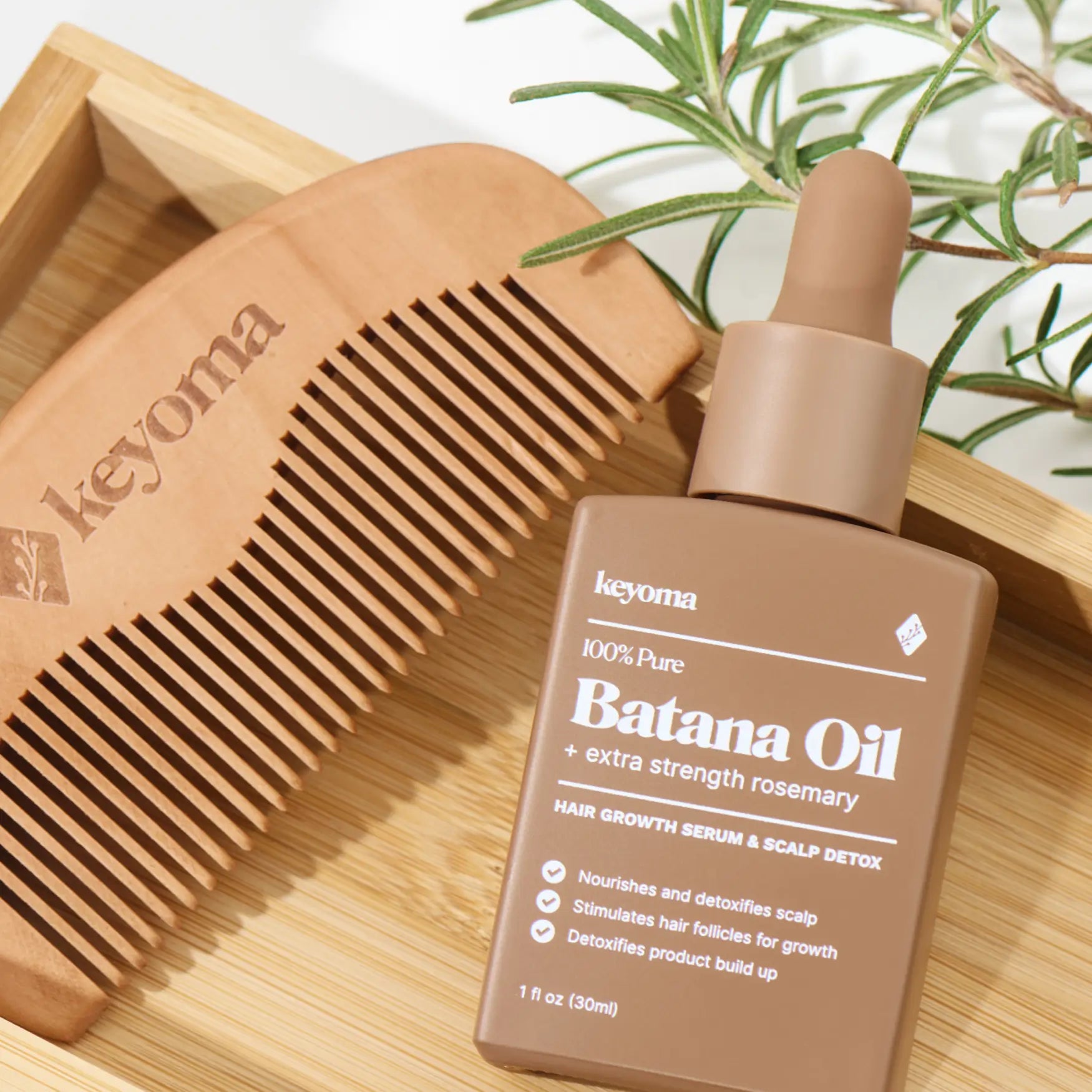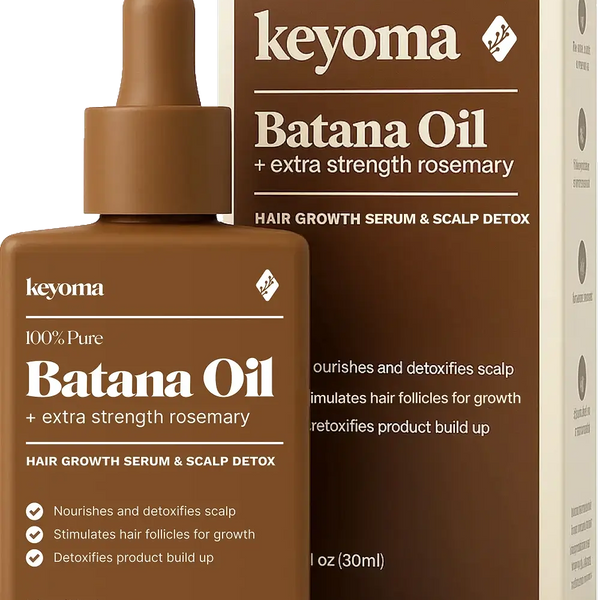In this article
Most people think hair just grows and falls out all at once. End of story. But that’s a big misconception. Spoiler alert: your hair actually goes through four distinct stages in its life cycle, and every single follicle follows its own timeline.
Why does knowing this matter? Because when that cycle gets thrown off, whether by stress, diet, hormones, or even how you wash your hair, your follicles start reacting. Maybe not immediately, but weeks or even months later, you’ll notice the signs: thinning, slower growth, or sudden shedding.
In this guide, I’ll walk you through the four stages of hair growth, what affects them, and what you can do to keep your cycle healthy and your hair growing strong.
The 4 Stages of Hair Growth
Anagen Phase
The anagen phase is your hair’s main growth phase. Under ideal conditions, the anagen phase can last anywhere from 2 to 6 years, and in some people even up to 7 years.
That explains why some people can grow super long hair while others plateau at shoulder length. It all depends on how long your follicles stay in this phase before cycling out.
During this stage, the follicle is hard at work pushing out new strands from the root, thanks to rapidly dividing cells in the hair bulb. Blood vessels in the scalp feed oxygen and nutrients to fuel that activity, while the follicle remains deeply anchored in the dermis.
Roughly 85–90% of all your scalp hairs are in this stage at any given time. The longer your anagen phase, the longer your potential hair length.
That’s also why most growth-focused treatments, like nourishing oils or scalp massage, focus on prolonging anagen.
Catagen Phase
The catagen phase is the transition phase. It's a short period of about 10 to 14 days where growth halts and the hair prepares to detach from its blood supply.
Here, the follicle starts to shrink, and the bulb that once churned out new cells begins to harden into what's called a club hair.
It’s a controlled shutdown. The lower part of the follicle collapses and moves upward toward the surface, but the strand itself doesn’t fall out just yet. It simply stops growing and enters a kind of limbo.
Less than 5% of your hairs are in this phase at a time.
Telogen Phase
The telogen phase is the resting phase of the hair cycle where the follicle remains inactive. No new growth, no cell division, no push from the root. The club hair (formed in catagen) just sits in place, loosely anchored.
It lasts about 2 to 3 months, and at any time, 10–15% of your scalp hairs are here.
However, if more than the usual percentage of follicles are stuck in telogen for too long, that’s when telogen effluvium (aka sudden hair shedding) can happen. While it's only temporary, this condition can leave your hair looking noticeably thinner for several months until the cycle stabilizes.
Exogen Phase
The exogen phase is the shedding phase, when those resting club hairs finally let go and fall out. This stage overlaps with telogen (which is why some sources describe only three stages of hair growth), but what sets it apart is that actual release happens here.
Hair in this phase is gradually pushed out, often through everyday mechanical actions like brushing, washing, or simple friction. The process can last anywhere from two to five months.
On average, we shed 50 to 100 hairs a day during exogen. It’s completely normal and part of a healthy growth cycle.
Factors That Disrupt the Hair Growth Cycle
Genetics
The most well-known condition tied to genetics is androgenetic alopecia, more commonly known as pattern hair loss—and it’s permanent.
This condition causes the follicles to gradually shrink over time, shortening the anagen phase and producing thinner, weaker strands until eventually, they stop growing altogether.
It usually happens when hair follicles become sensitive to DHT (dihydrotestosterone), a hormone derived from testosterone. In that sense, that means you could be born with more DHT receptors or just be more reactive to it.
Age
As we age, everything slows down, including the hair growth cycle. The anagen phase shortens, telogen lasts longer, and follicles take more time to re-enter growth.
Gradually, you may notice reduced density, finer strands, and a scalp that’s a bit more visible under bright light.
One reason behind this is a natural drop in cell regeneration and collagen production. Blood circulation to the scalp can also weaken, meaning less oxygen and nutrients reach your follicles.
Hormonal Changes
Another thing that comes with age is hormonal shifts. When hormone levels, particularly estrogen, progesterone, and thyroid hormones, dip—as in menopause, postpartum, or thyroid imbalances—it disrupts the balance of the hair growth cycle.
Follicles are signaled to shift prematurely into the telogen phase. That means more hair resting, less growing.
In fact, this explains why many women experience heavy shedding a few months after giving birth.
During pregnancy, most hair stays in the anagen (growth) phase longer than usual. Then, after delivery, it collectively transitions into telogen—and eventually exogen—all at once.
Stress
When your stress levels stay high, your body releases more cortisol, the hormone that governs your fight-or-flight response. Over time, cortisol can push hair follicles into the telogen phase prematurely.
You likely won't notice it immediately as shedding occurs in 2-3 months after a major stressful event. Fortunately, this is reversible, especially when you take measures to manage stress and normalize cortisol levels.
Even so, it's important to note that chronic stress can keep the cycle stuck in repeat, gradually shrinking the anagen phase and weakening the regrowth.
Nutritional Deficiencies
When you’re low on nutrients like protein, iron, zinc, and certain vitamins, your body redirects them to essential organs instead.
Hair follicles, being non-essential, get deprioritized. This results in shortened anagen phases, stalled growth, and more strands shifting into telogen and exogen.
This manifests as early signs like dull, brittle hair or sudden shedding, which, when left unchecked, can lead to diffuse thinning across the scalp.
Illnesses and Infections
Much like what happens during nutritional deficiencies, when your body’s fighting off illness, it redirects its energy toward vital organs and away from non-essential processes like hair growth.
Systemic infections, high fevers, autoimmune conditions, or chronic inflammation can all disrupt the hair growth cycle, often pushing more follicles into the telogen phase earlier than normal.
If the root cause is temporary and properly treated, the cycle usually resets on its own. But if the illness is chronic or autoimmune, the disruption may persist and require medical attention for long-term management.
Medications
Certain medications can interfere with how your follicles cycle through the growth, rest, and shedding phases. These aren’t just limited to chemotherapy drugs—although that’s one of the most common examples.
Everyday medications like antidepressants, blood pressure drugs, acne treatments, and birth control pills can also disrupt the cycle’s timeline.
The way each drug causes this disruption depends on its mechanism. Some alter hormone levels, others affect nutrient absorption, and a few directly impact the follicle’s metabolic activity.
For most people, the effect is reversible once the medication is stopped or adjusted under medical supervision. However, shedding may continue for several months even after discontinuation, simply because the hair growth cycle takes time to reset.
Injuries to the Head or Scalp
Physical trauma to the scalp, whether from surgery, deep cuts, burns, or blunt force, can directly disrupt the hair growth phases by damaging the follicles themselves or the surrounding tissue that supports them.
When the skin is injured, the healing process can trigger premature entry into the catagen or telogen phase for nearby follicles. In more severe cases, it may lead to scarring alopecia, where the follicle is destroyed and cannot regrow hair at all.
Bad Hair Product Choices
Sulfate-heavy shampoos, alcohol-based sprays, and chemical-laden treatments (like certain dyes or relaxers) are common culprits that mess with your hair cycle’s rhythm. They can strip away the scalp’s natural oils and inflame the follicles’ environment.
That inflammation disrupts the anagen phase, shortens growth time, and may push more strands into telogen earlier than they should.
Watch out for warning signs like an itchy or tight-feeling scalp, unusual fallout after switching to a new product, or hair that suddenly feels limp and brittle. Those are your cues that something in your routine isn’t working.
Seasonal Changes
Yes, even the weather can shift your hair’s natural cycle. Research has shown that seasonal shedding is a real thing, especially during late summer and early fall.
This happens because changes in daylight, UV exposure, humidity, and even vitamin D levels can affect the signals your scalp sends to your follicles. During warmer months, more strands tend to stay in anagen, but by autumn, a larger number shift into telogen, preparing to shed.
Seasons
Yes, even the weather can shift your hair’s natural cycle. Research has shown that seasonal shedding is a real thing, especially during late summer and early fall.
This happens because changes in daylight, UV exposure, humidity, and even vitamin D levels can affect the signals your scalp sends to your follicles. During warmer months, more strands tend to stay in anagen, but by autumn, a larger number shift into telogen, preparing to shed.
Tips to Maintain Hair Health Through the Hair Growth Cycle
Apply Natural Hair Oils
Beyond the obvious benefit of moisturizing your hair, natural hair oils help create an environment that supports longer anagen phases through mechanisms like:
-
Vasodilation: widening blood vessels for better circulation
-
Anti-inflammatory action: calming the scalp to reduce follicle disruption
-
Lipid barrier repair: keeping the scalp protected and hydrated so follicles can thrive
Oils like batana, rosemary, peppermint, even the classic coconut oil, nourish the follicle directly and improve barrier function, helping reduce inflammation that might otherwise disrupt the cycle.
The best part is when combined with scalp massage, as this pairing further stimulate blood flow to the scalp.
Nourish with Balanced Nutrition
Before you put all your trust into supplements to carry the nutrient load (they’re called supplements for a reason), make it a habit to include a healthy, balanced mix of hair-supportive foods in your daily meals:
-
Protein-rich foods like eggs, fish, and lentils: because keratin (the main component of your hair) is made from amino acids that only come from protein.
-
Iron sources like red meat or spinach: helps carry oxygen to your follicles (pair it with vitamin C to help your body absorb it better)
-
Healthy fats from foods like salmon or walnuts: helps regulate hormones and keep your scalp nourished, creating the ideal environment for steady growth.
Manage Stress Proactively
Do simple things like taking daily walks, practicing deep breathing, journaling, and—arguably the most important yet often overlooked—getting seven to nine hours of quality sleep.
This helps lower cortisol levels, a major culprit that too often pushes follicles into the telogen stage prematurely.
Avoid Bad Hair Care Habits
Below is a list of common hair care mistakes, often small habits that seem harmless but, when repeated over time, can interfere with your hair cycle. These are the ones you’ll definitely want to avoid:
-
Tight hairstyles every day: Constant pulling from ponytails, braids, or buns can lead to traction alopecia and shorten the growth phase.
-
Overwashing or scrubbing harshly: This strips away protective oils, dries out the scalp, and irritates the follicle environment.
-
Skipping conditioner: Without moisture, strands become brittle and more prone to breakage during the growth cycle.
-
Using hot tools daily without protectant: High heat weakens the cuticle layer, leading to split ends that travel up the shaft and interfere with healthy growth.
-
Sleeping with wet hair or on rough pillowcases: This creates unnecessary friction and breakage during the exogen phase.
-
Neglecting scalp buildup: Product residue and oil clog follicles and can block new hairs from emerging.
Frequently Asked Questions (FAQs)
Can I "restart" the hair growth cycle?
You cannot restart a hair growth cycle that is already destroyed, such as in cases of scarring alopecia, where the follicles are permanently damaged. But if follicles are merely dormant or miniaturized, it’s possible to stimulate them back into activity.
Medical treatments (e.g. minoxidil, finasteride), lifestyle changes, and consistent scalp care may help encourage these follicles to re-enter the anagen phase and improve the health of those already growing.
How to increase anagen phase of hair?
The anagen phase can be prolonged by supporting follicle health. Try habits like regular scalp massage, using vasodilating oils (like rosemary or peppermint), and maintaining a nutrient-rich diet with enough protein, iron, and vitamin D. These promote longer growth phases and reduce premature shifts into telogen.
Is the female hair growth cycle different from men?
The basic stages—anagen, catagen, telogen, and exogen—are the same. But hormonal differences cause female and male cycles to behave differently.
Women tend to shed more diffusely, while men often experience recession and crown thinning due to DHT sensitivity. Hormonal shifts (like menopause or postpartum) also impact female hair more dramatically.
How quickly does hair grow?
Healthy scalp hair grows at about 0.35 mm per day, which equals 1 cm per month or roughly 6 inches per year. However, growth can vary based on age, hormones, nutrition, and overall follicle health.
How long is the life cycle of hair?
Each hair follicle has its life cycle. In fact, individual follicles cycle independently, and over your lifetime, each one can complete 10 to 30 full hair cycles, according to research from the International Journal of Molecular Sciences.
Final Thoughts
The hair growth cycle isn’t just a biology textbook concept. It’s an actual living process that's influenced by the smallest things you do every day. From stress and diet to the way you wash, sleep, and style your hair, everything either supports the cycle or slows it down.
Personally, I use topical hair oils regularly, specifically rosemary-infused batana oil, and it's worked for my hair for years now. Of course, that's best paired with real, whole foods getting proper sleep.
How about you? What’s one thing you could start doing differently today to support your hair’s rhythm?
If you want more practical tips, product routines, or science-backed hair care guides, you’ll find plenty over at the Keyoma Blog. I share everything I learn and actually use there—all for free!
Featured Product
100% Pure Batana Oil + Rosemary









